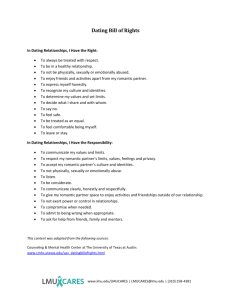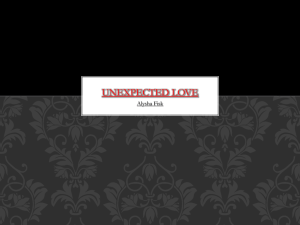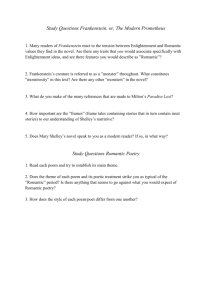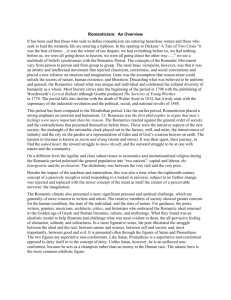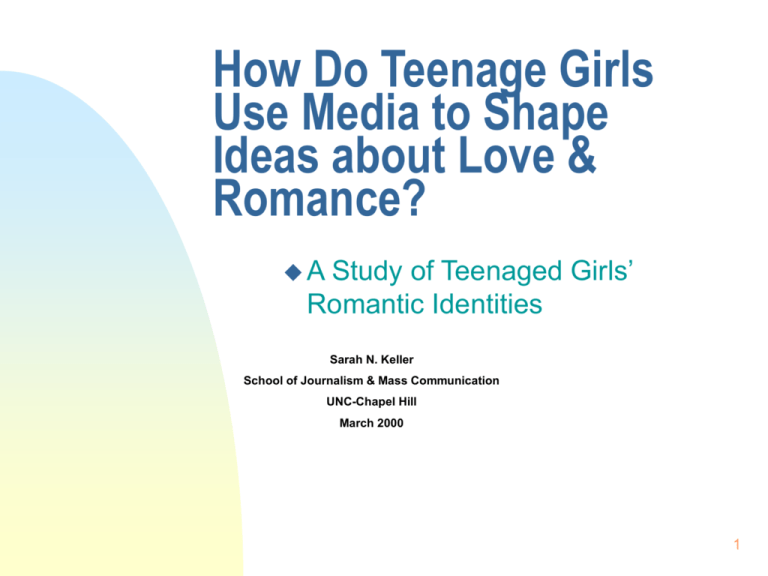
How Do Teenage Girls
Use Media to Shape
Ideas about Love &
Romance?
A Study
of Teenaged Girls’
Romantic Identities
Sarah N. Keller
School of Journalism & Mass Communication
UNC-Chapel Hill
March 2000
1
Introduction
If we can better understand what role the
media play in how girls think about love
and romance, we will be better able to
develop sexual health messages.
Media
Romantic
beliefs
Sexual risks
2
Specific Aims
Assess need:
how
do young girls use media to shape
attitudes and beliefs about romance?
Plan strategy:
develop
& test audience segmentation
strategy based on romantic beliefs
Design message:
what’s
media environment?
pilot an educational web site
3
Sexual Risk for Teen Girls
Girls twice as likely as boys to get common
STDs
Girls ages 15-19 highest gonorrhea rates in U.S.
Asymptomatic infections harder to diagnose
Long-term complications more serious
Young women have special risk:
thinner
cervical mucus
multiple partners
Less negotiating power in relationships
CDC. HIV/AIDS Surveillance Report 1994; 5:1-36. Germain A, Wasserheit J, eds.
Reproductive Tract Infections: Global Impact and Priorities for Women’s Reproductive
Health. New York: Plenum Press, 1992.
4
Sexual Media Content
Media scripts convey frequent messages about
love & sex, but few mention risks and
responsibilities.
Prime-time TV: 1 in 10 scenes mention risks,
protection or consequences
Internet: 2.2 million sites on “sex
education” (most are pornographic)
Advocates for Youth. Talking with TV. Washington: Advocates for Youth, 1996.
Dale K, et al. Sexual Messages on Family Hour TV: Content and Context.
Santa Barbara: Children Now, Kaiser Family Foundation, 1996. Huston, Wartella & Donnsertein, 1998.
5
Dominant Sexual Scripts
Traditional script (in Seventeen Magazine)
precludes:
sex
outside marriage
female desire & pleasure
promotes:
heterosexual
orientation
intercourse (over other sexual acts)
Carpenter, L. (1998). From girls to women: Scripts for sexuality and romance in Seventeen
Magazine, 1974-1994. The Journal of Sex Research, 35, 2, 158-169.
6
Dominant Romantic
Scripts
Recreational orientation to sex (on
prime-time TV):
cheating;
scoring
stealing partners
fighting over dates
Relational orientation to sex:
emphasis
on love & happiness
Ward, L.M. (1995). Talking about sex: Common themes about sexuality in
the prime-time television programs children and adolescents view most.
Journal of Youth and Adolescence, 24(5), 595-616.
7
Media Effects
Girls who accept dominant romantic
script(s) may be vulnerable to greater
sexual risks:
Focus
group research shows that girls who
idealize romance are least likely to plan out
sexual encounters and use contraception.
Longitudinal study finds girls who subscribe
to traditional female stereotypes initiate
sexual intercourse earlier.
Thompson, 1995; Foshee & Bauman, 1992.
8
Reactions to Romantic
Content Vary
Not all girls get the same messages.
Adolescents seem to cluster into distinct
categories of romantic or sexual beliefs.
These categories may be correlated with
specific patterns of media use.
Thompson, 1995; Pipher, 1994; Brown, White and
Nikopoulou, 1993; Buzwell & Rosenthal, 1996.
9
Can Adolescent Girls Be
Segmented by Identity?
Categories of girls’
relationship behavior
(Thompson, 1995)
Romantic idealists
Hell-raisers
Sporting Girls
Players
Fast-track career girls
Mothers
How girls use sexual
media (Steele & Brown,
1995)
Disinterested
Intrigued/Conformers
Resisters
?
?
10
Research Questions
R1. Can a coherent set of Romantic
Identities be distinguished among
early adolescent girls?
R2. What role do media play in
development of young girls’
Romantic Identities?
11
Research Design
Focus groups
segment
audience
identify need
design web site
Written questionnaire
pilot
test measures
Web pilot test
refine
site’s effectiveness
12
Sample
Number:
Focus
groups (n = 7 groups x 2-12 = 46)
Survey (n = 128)
Web pilot-test (n = 26)
Age: 11-15
Gender: Female
Subgroup: Upper middle-class, middle-class and lowincome, white & African-American.
Location: Teen programs & schools in North Carolina
& New York
13
Focus Groups
Assessing need, defining the audience &
designing the message
Focus group questions:
what
romantic/sexual messages do you get
from the media?
how do you think about love and romance?
what messages would you prefer to see?
Media exercises
select
images from magazines
view and discuss prime-time TV clips
14
Survey
Written questionnaire
Romantic
Identity Typology -
asks
respondents to rate how much they are “like”
or “not like” each of 6 romantic identity types
Dating
expectations -
asks
respondents to rate how important they
perceive each of 6 qualities of dating to be
Open-ended
media questions
External validity checked in individual interviews
15
Web Pilot Test
Students convened in computer labs
Each given PC and web site
Navigated individually for 10-15 minutes
Group debriefing on:
usefulness,
like/dislike, and suggestions
did they relate to any Romantic Identity Types?
if so, which ones did they pick and why?
16
Hi girls!!!!
What's up?
Have you ever thought about what your romantic identity is.....?
Well, enter this page and you'll get some answers.
Are you a...romantic
idealist?
An independent thinker?
A shy girl?
A rebel?
A down-home, countryWestern gal?
Or a career planner?
I'm sort of a romantic idealist...
I get sad when I listen to songs about heartbreak. I'm happy when I hear songs about
true love.
Sometimes I feel both emotions at once, like
with "Angels in Disguise," by Brandy. It's
such a pretty song. Everyone should hear
it. More about me...
I don’t think everyone should try too
hard to find love. It’ll just happen.
We talked with some other girls our age and came
up with some ideas about how media messages
could be improved.
Well, after thinking about the whole love issue some more, we
decided that:
Media should give us information about other stuff, like conservation
and killing of the whales.
There should be a news show by teenagers, instead of Dan Rather.
Everyone wants to find a match, but you shouldn’t think about love all
the time.
Results
Focus Groups
Three
readings
Surveys
Descriptives
Bivariate
analysis
independent t-tests
Web pilot-test
Qualitative
data analysis
22
Focus Group Results
Identity types & media preferences: Girls
chose magazine images that related to their selfassigned Romantic Identity categories
“I chose this image because she’s kind of weird-looking
and strange. Because she’s out there, kind of weird
looking, like me.” - 13-year-old Raleigh girl, rated as
Independent Thinker
“I picked this girl, cuz she looks kind of mad, like
something just got on her nerves, and I’m having a bad
day today, so I can relate to her.” - A self-described Hellraiser from Raleigh, age 11.
23
Focus Group Results (cont’d)
Romantic media content: Girls agreed that TV
and magazines idealize romantic relationships,
but disagreed about whether that should be
different.
“Life is about relationships. Sex is part of relationships.
What else would the show [Dawson’s Creek] be about?” Romantic Idealist.
“Except you never see family relationships on TV,” - Shy
Girl.
“It might make you more depressed cuz you realize that
you don’t have it. Family. Cuz you didn’t have a good
family situation, or not many friends,” - Independent
Thinker.
24
Frequencies of Romantic
Identity Types (n=128)
Mother
Sporting Girl
Player
Career Girl
Frequency
Romantic Idealist
30
25
20
15
10
5
0
Percentage of girls ages 11-15 who rated themselves “just like”
each type, on a scale from 1-4.
25
Psychometric Evaluation
Internal reliability:
Are
Romantic Identity Types correlated with
each other?
Most categories appear distinct:
Sporting
Girl negatively correlated with
Romantic Idealists (r = -.362, p = .000).
Some
categories overlap:
Mothers
& Players positively correlated with
each other (r = .256, p = .006)
Sporting Girls & Fast-track Career Girls (r =
.355, p = .000)
26
Psychometric Evaluation
Concurrent construct validity:
Are
identity types correlated with:
dating
salience?
dating expectations?
media uses?
27
Identity Types & Dating
Dating
salience:
Dating
salience was correlated with high
score on Romantic Idealist & Player
questions
Romantic Idealists and Players said dating
was VERY important (r =.391, p =.000; r =
.402, p = .000).
Sporting & Career Girls said dating was
NOT important (r = -.490, p = .000; r =
-.235, p = .002).
28
Identity Types & Dating
Dating expectations:
Dimensions
were correlated with Romantic
Identity Types as expected
Sporting Girls said friendship was important (r =
.247, p = .023), but NOT romance and passion
(r = -.234, - .232, p = .003).
Romantic Idealists and Players chose passion
and romance as important (r = .210, r = .320; r
= .245, r = .392, p = .000).
Love was rated highly by Players (r = .251), but
less highly by Romantic Idealists (r =.134).
29
Media Use & Romantic Beliefs
Girls who watched more TV tended
to rate involvement in dating
relationships as more important
TV hours and dating salience were
positively correlated (r = .195, p =
.02)
Saturday TV watching and dating
salience were even more related
(r = .427, p < .01)
30
Media Use & Romantic
Identity
Web:
Sporting Girls
Players & Romantic Idealists
music uses of web (e.g., www.mtv.com)
chat rooms (Teen Chat or Black Voices
Teen)
Fast-track Career Girls
“other” uses of web (e.g.,
www.yahoo.com, www.abc.com)
31
Romantic Identity Types Media
Preferences (n=128)
Media
Genre
Romantic
Idealist
(n=37)
Mother
Player
(n=16)
(n=27)
Sporting
Girl
(n=17)
Career
Girl
(n=27)
Primetime
TV
Talk show PrimeTalk show Primetime
time &
Talk show
Magazine
Teen
Teen
Teen
Teen
Teen
Music
Rap
Rap
Rap
Male pop
Rap
Web
Chat
Chat
Chat
Music
Other
32
Web Pilot Results
Identity types resonated with web users:
“I
like the Rebel page and the Romantic Idealist
page. I like the Rebel, because it says you don’t
always have to like what everyone else likes. You
don’t have to agree with everyone else’s
opinions. I liked the Romantic Idealist because it
reminds me of myself.” - African-American girl,
13, East Harlem Secondary School
Identity choices shown to be transient - Girls
often identified with more than one category.
33
Discussion
R1: Is it possible to distinguish Romantic
Identities among young teen girls using
this Typology? Yes.
Respondents
from diverse backgrounds
grouped into each category (except Hellraisers).
Variations for race & age not significant except for Sporting Girls.
Overlap may indicate the types represent
dimensions rather than complete selves.
34
Discussion
R2: Do teen girls use media to shape
ideas about romance, love &
relationships? Yes, but exactly how is
not yet clear.
Identity
types had somewhat different
patterns of media use.
Early adolescent girls agreed media
place a heavy emphasis on love and
romance.
Heavy TV viewers tended to place more
importance on dating.
35
Discussion
Web pilot test comments indicate
that Romantic Identity Typology
may be a useful audience
segmentation strategy for
delivering health communication
messages to female adolescents.
36
Future Research
Evaluate a revised version of web site for
impact on sexual beliefs and attitudes
use
experimental design
use online questionnaire to measure baseline
& post-test variables
Incorporate web site into media literacy
curriculum and evaluate for impact
use
dependent variables derived from focus
group data - relationship salience, romantic
self-esteem and media critical awareness
37
Future Research
Test audience segmentation
strategy - i.e., the Romantic Identity
Typology
with
representative sample of teen
Internet users
with an educational web intervention
that is evaluated for impact
38

